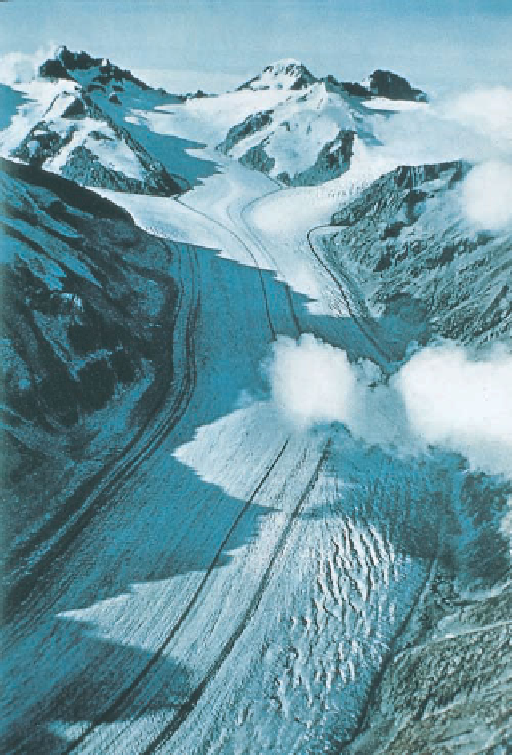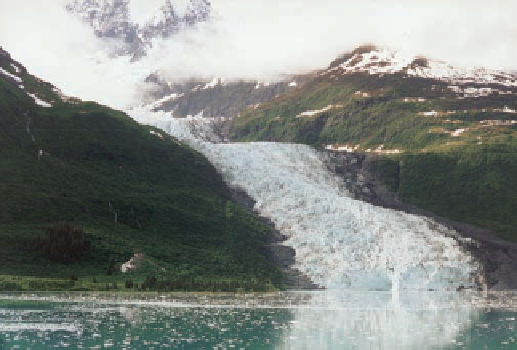Geology Reference
In-Depth Information
surfaces they move over, producing many easily recogniz-
able landforms, and they deposit huge amounts of sediment,
much of it important sources of sand and gravel. Glaciers
today cover about 10% of Earth's land surface, but during the
Ice Age they were much more widespread.
Studying glaciers and their possible causes may clarify
some aspects of long-term climatic change and the debate
on global warming (see Geo-Focus on pages 364 and 365).
Glaciers are very sensitive to even short-term changes in cli-
mate, so scientists closely monitor them to see whether they
advance, remain stationary, or retreat.
defi nition are
moving
and
on land
. Accordingly, permanent
snowfi elds in high mountains, though on land, are not gla-
ciers because they do not move. All glaciers share several
characteristics, but they differ enough in size and location
for geologists to defi ne two specifi c types, valley glaciers and
continental glaciers, and several subvarieties.
Valley glaciers are confi ned to mountain valleys where they
fl ow from higher to lower elevations (
Figure 14.2), whereas
continental glaciers cover vast areas, they are not confi ned
by the underlying topography, and they flow outward in
all directions from areas of snow and ice accumulation. We
use the term
valley glacier,
but some geologists prefer the
synonyms
alpine glacier
and
mountain glacier
. Valley gla-
ciers commonly have tributaries, just as streams do, thereby
forming a network of glaciers in an interconnected system
of mountain valleys.
Valley glaciers are common in the mountains of western
North America, especially Alaska and Canada, as well as the
Andes in South America, the Alps in Europe, the Alps of New
Zealand, and the Himalayas in Asia. Even a few of the loft-
ier mountains in Africa, though near the equator, are high
enough to support small glaciers. In fact, Australia is the only
continent that has no glaciers.
A valley glacier's shape is obviously controlled by the
shape of the valley it occupies, so it tends to be a long, nar-
row tongue of moving ice. Valley glaciers that fl ow into the
ocean are called
tidewater glaciers
; they differ from other val-
ley glaciers only in that their terminus is in the sea rather
than on land (Figure 14.2b).
Valley glaciers are small compared with the much more
extensive continental glaciers, but even so, they may be as
large as several kilometers across, 200 km long, and hundreds
of meters thick. Some glaciers in Alaska are up to 1500 m
thick. Erosion and deposition by valley glaciers were responsible
for much of the spectacular scenery in several U.S. and Cana-
dian national parks, notably Yosemite, Glacier, and Banff-Jasper.
◗
Geologists defi ne a
glacier
as a moving body of ice on land
that flows downslope or outward from an area of accu-
mulation. We will discuss how glaciers fl ow in a later sec-
tion. Our definition of a glacier excludes frozen seawater
as in the North Polar region, and sea ice that forms yearly
adjacent to Greenland and Iceland. Drifting icebergs are not
glaciers either, although they may have come from glaciers
that fl owed into lakes or the sea. The critical points in the
◗
Figure 14.2
Valley Glaciers
b
Wellesley Glacier in Alaska fl ows into the sea, so it is a tidewater
glacier.
a
A valley glacier in Alaska. Notice the tributaries that unite to
form a larger glacier.




Search WWH ::

Custom Search